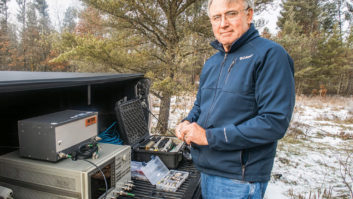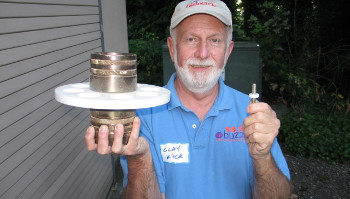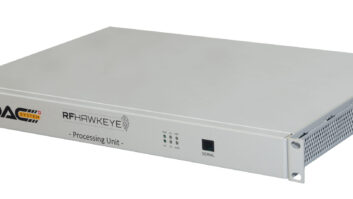(click thumbnail)Clay Freinwald at Entercom’s Seattle Cougar Mountain facility.When broadcast leaders recently realized they needed to meet with regulatory and weather officials to plan changes in the Emergency Alert System, it was Clay Freinwald who arranged the meeting.
That typifies the role he has played as radio has participated in, and helped define, the nation’s evolving alert infrastructure.
Clay Freinwald is the recipient of Radio World’s 2007 “Excellence in Engineering” Award.
Mountain cats
His interest in technology came early, with a fascination with ham radio and taking apart radios, TV sets and alarm clocks. Through the electronics program at his Seattle-area high school he got a hands-on education in engineering and production that led to a full-time job as a combo engineering/on-air man at a 1 kW AM directional.
In 1966, he fielded separate offers to work as a chief and as a country jock. He credits Chuck Ellsworth with the advice that made up his mind: “Programming is a revolving door. You have a lot of technical talent, Clay. Capitalize on that.”
Soon after he noticed that KMO(AM) in Tacoma was having a problem and dropped in to help, launching a long relationship with that station. He has worked as a chief, cluster or corporate engineer under several owners including Tribune Publishing, Viacom and Entercom, helping move stations from Tacoma to Seattle and building transmitter sites and studios.
He was a cluster DOE for Entercom, then spent six years as a corporate engineer, traveling extensively and implementing HD Radio in numerous markets.
After recent changes in Entercom’s structure, Freinwald now is an RF systems engineer, a suitable role for a man who built major facilities at Tiger Mountain and Cougar Mountain, not to mention a 50 kW, four-tower directional AM — “some good, seven-figure projects.”
Tiger is home to eight FM main transmitters and an ERI combiner, and the facility has been adapted to accommodate HD Radio; Cougar has eight standbys and one main, as well as an eight-station Shively combiner, and there too stations are looking to digital.
“The time is coming when we’ll have to have backup HD facilities. We’ve had a couple of cases where we had to shutdown the HDs on a Sunday morning.” Programmers have made clear that’s not an option. Freinwald also does contract work for clients such as KING(FM) and Bustos Media.
Vision for EAS
He has worked for four decades in the same market. If you don’t live in Seattle yet you know his name, it’s probably because of EAS.
The work is volunteer. At KMO he became involved as assistant state EBS chair; soon John Price, coauthor of an SBE primer on the new EAS, took him to lunch and did some serious arm-twisting. Freinwald agreed to become state chair and formed the State Emergency Communications Committee in 1996 to write and implement an EAS plan.
“I took EAS in quite a different direction that most states; we were not going to repeat the very things that made EAS so subject to criticism. We built a state relay network based on mountaintop VHF transmitters; but we don’t have daisy chains or LP stations. The LP2 in Seattle is the National Weather Service, which is fully automated and integrated with EAS.”
The key ingredient in Washington State’s EAS plan is an active SECC that has representation from the FCC, NWS, state and local governments as well as radio and television stations. Many on the SECC have been there for more than 11 years.
Subsequently elected to the national SBE board, his committee assignment was, of course, EAS. “I started making myself available and running around the country talking about how to make EAS more effective.”
Freinwald (SBE member number 714) is completing a term as society vice president. He has chaired the national EAS committee since 2000 and was coauthor with Rudman of the society’s “Vision for EAS,” published last year. Freinwald said he is “fiercely proud” of colleagues on the EAS committee including Adrian Abbott, Richard Rudman, Art Botterell, Gary Timm, Alan Alsobrook and Jerry LeBow.
In 2005 SBE made one of its largest filings as part of the commission’s Further Notice of Proposed Rule Making, EB Docket 04-296. The society wrote, “EAS has reached a point where simple modifications or Band-Aid approaches are no longer applicable. The most recent [report and order] augmenting the EAS is a clear call for the application of additional technology to not only correct existing issues, but make changes in the way the systems works in order to enable the EAS to move forward and serve more U.S. citizens via an ever-growing number of electronic communication systems.”
Freinwald, who worked with Dane Ericksen on the project, was delighted the FCC adopted many of the society’s recommendations, including Common Alerting Protocol. The report and order, he says, demonstrated “substantial changes in the FCC’s mind about how EAS should function.” However, he also feels it was long on conceptualizing and short on details.
“We don’t have specificity. We’re working with an executive order that came out after Katrina; Part 11 of the rules; the further notice that was just released; and the General Accounting Office report on EAS, which was not exactly complimentary.
“The ‘how to get it done, son’ is going to come out of FEMA,” he continued, but SBE leaders “are gonna do all we can to help that process.” Thus he was asked to bring together SBE, NAB and the National Alliance of State Broadcasters Associations to meet with officials of the FCC, National Weather Service and, he hoped, FEMA to learn what those entities are thinking.
Checkerboard
Freinwald calls the existing state of EAS ���a checkerboard of functional and dysfunctional systems” and says it’s unfair to criticize it broadly given that the system is one with multiple federal, state and local components.
“But broadcasters are no longer the kingpin of the public warning thing; we’re relegated to being another tool in the toolbox. Which is good.” Users of Apple appliances, for example, “are not going to be happy with a scratchy-sounding audio signal. CAP is a way of getting text, voice and pictures from the sources to the public; nothing in EAS allowed that.”
How large an impact the pending changes will have depends on what state you’re in; many decisions have yet to be made. (For instance, he noted that some manufacturers are calling products “CAP-compliant” yet authorities have not yet described how CAP will function to meet the requirement that a state governor may issue warnings that must be carried.)
Freinwald has been an SBE member since 1968; he’s been honored as the society’s engineer of the year not once but twice, and the Washington State Association of Broadcasters has honored him as a past broadcaster of the year for his work on EAS.
Clay Freinwald, CPBE, age 65, has no plans to retire — “I’m having too much fun.” But he worries about where the next generation of RF experts will come from. “In the Seattle market, there are two radio engineers and two or three TV transmitter engineers who are all in their mid-60s. When they retire and/or leave, who’s gonna replace them?”
Radio managers, he said, often hear about new media and are “scared to death they’ll be left in the dustbin of history along with the daily newspaper if they don’t somehow get themselves involved in the technology revolution.” But in so doing, he said, companies may fail to realize the importance of nourishing their RF staffs and will soon realize “the IT guy doesn’t want to deal with something that has an 8,000-volt meter on it.”













